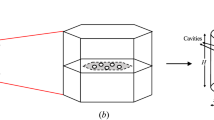Abstract
We analyze the effect of hydrogen on the growth of fatigue cracks in structural steels depending on their strength and testing temperature. For low temperatures (T≤200°C), the effect of hydrogen is ambiguous and depends both on mechanical strength and the level of loading. Under high loads, the effect of hydrogen is similar to that of corrosive environments and is often called hydrogen embrittlement. Under low loads (near the fatigue threshold), the effect of hydrogen depends on the strength of steel and results in smaller crack closures and decreased resistance to normal cleavage fracture or increased resistance to shear for high-strength and low-strength steels, respectively. The effect of hydrogen is unambigous at high temperatures (T≥400°C) and can be described as a decrease in shear resistance and an increase in the fatigue crack-growth rates.
Similar content being viewed by others
References
N. R. Moody and A. W. Thompson (editors),Hydrogen Effects on Materials Behavior, TMS, Warrendale, Pa (1991).
A. W. Thompson and N. R. Moody (editor),Hydrogen Effects in Materials, TMS, Pa (1996).
V. V. Panasyuk (editor),Fracture Mechanics and Strength of Materials: A Handbook, Vol. 4: O. M. Romaniv, S. Ya. Yarema, and H. M. Nykyforchyn, et al.,Fatigue and Cyclic Crack-Growth Resistance of Structural Materials [in Russian], Naukova Dumka, Kiev (1990).
H. M. Nykyforchyn, O. M. Romaniv, and M. Schaper, “The influence of gaseous environments on crack propagation in steels,” in:Vortrage zur 17. Metalltanung. Informationsgeselschaft, Dresden (1990), pp. 367–376.
O. M. Romaniv, H. M. Nykyforchyn, I. D. Skrypnyk, and M. Schaper, “Influence of hydrogen on deformation and torsional fracture of high-strength steel,”Fiz.-Khim. Mekh. Mater.,29, No. 4, 93–101 (1993).
H. M. Nykyforchyn, O. Z. Student, and I. D. Skrypnyk, “Double influence of hydrogen on the growth of fatigue cracks in heat-resistant steels,”Fiz.-Khim. Mekh. Mater.,30, No. 4, 7–15 (1995).
H. M. Nykyforchyn, I. D. Skrypnyk, and O. Z. Student, “Fatigue crack-growth resistance of HK-40 steel in gaseous hydrogen,” in:Proceedings of the 8th Internat. Conference on Fracture: Advances in Fracture Resistance of Materials (ICF8, Kiev, 1993), Vol. 2, Tata McGraw-Hill, New Delhi (1996), pp. 621–628.
S. Suresh, C. M. Moss, and R. O. Ritchie, “Mechanistic dissimilarities between environmentally influenced crack propagation at near threshold and higher growth rates in low-strength steels,”Metal. Sci. 16, No. 11, 529–539 (1982).
P. McIntyre, “Interactions between hydrogen and steels during cyclic loading,” in:Proceedings of the 1st USSR-UK Seminar on Corrosion Fatigue of Metals: Corrosion Fatigue, Metals Society, London (1980), pp. 62–73.
A. T. Stewart, “The influence of environment and stress ratio on fatigue crack growth at near threshold stress intensities in low-alloy steel,”Eng. Fract. Mech.,13, 463–478 (1980).
S. Suresh, G. F. Zamiski, and R. O. Ritchie, “Oxide-induced crack closure: an explanation for near-threshold corrosion fatigue crack growth behavior,”Met. Trans.,12A, 1435–1443 (1981).
H. M. Nykyforchyn and L. Yu. Kozak, “On the methodology of the evaluation of cyclic crack resistance of structural steelsin gaseous media,”Fiz.-Khim. Mekh. Mater.,22, No. 2, 69–73 (1986).
S. Ya. Yarema and O. D. Zinyuk, “Cyclic crack-growth resistance of magnesium alloys in a vacuum, in humid air, and in high-dried air,”Fiz.-Khim. Mekh. Mater.,22, No. 4, 26–34 (1986).
S. Ya. Yarema,A Method for the Determination of Crack Growth Rates and Crack Extension Resistance under Cyclic Loading [in Russian], Karpenko Physicomechanical Institute, Ukrainian Academy of Sciences, L'viv (1994).
J. Petit, B. Bouchet, C. Gasc, and J. de Fonquest, “A contribution to the study of the influence of environment on the crack growth rate of high-strength aluminum alloys in fatigue,” inProceedings of the 4th Internat. Conference on Fracture: Adv. Res. Strength Fract. Mater. (Waterloo, 1977), Pergamon Press, New York et al. (1978), pp. 867–872.
M. M. Shved,Changes in the Service Characteristics of Iron and Steels under the Influence of Hydrogen [in Russian], Naukova Dumka, Kiev (1985).
H. M. Nykyforchyn, “Mechanical situation at the tip of a corrosion-fatigue crack and the cyclic crack resistance of steels,”Fiz.-Khim. Mekh. Mater.,24, No. 2, 3–12 (1988).
O. P. Ostash and V. T. Zhmur-Klimenko, “Fatigue crack growth in metals at low temperatures”Fiz.-Khim. Mekh. Mater.,23, No. 2, 17–29 (1987).
H. G. Nelson, “On the mechanism of hydrogen-enhanced crack growth in ferritic steels.” in:Proceedings of the 2nd Conf. on the Mechanical Behavior of Materials (Boston, 1976), American Society for Metals, Boston (Mass) (1976), pp. 690–694.
Yu. I. Archakov,Hydrogen Resistance of Steel [in Russian], Metallurgia, Moscow (1979).
I. A. Clum, “The role of hydrogen in dislocation generation in iron alloys,”Scr. Met., No. 1, 51–58 (1975).
F. M. Vitovec, “Effect of high-pressure hydrogen environment on the creep behavior of steel,” in:Fracture Problems and Solution in the Energy Industry, Pergamon Press, Oxford (1982), pp. 107–114.
Additional information
Karpenko Physicomechanical Institute, Ukrainian Academy of Sciences, L'viv. Published in Fizyko-Khimichna Mekhanika Materialiv, Vol. 33, No. 4, pp. 97–106, July–August, 1997.
Rights and permissions
About this article
Cite this article
Nykyforchyn, H.M. Effect of hydrogen on the kinetics and mechanism of fatigue crack growth in structural steels. Mater Sci 33, 504–515 (1997). https://doi.org/10.1007/BF02537547
Received:
Issue Date:
DOI: https://doi.org/10.1007/BF02537547




